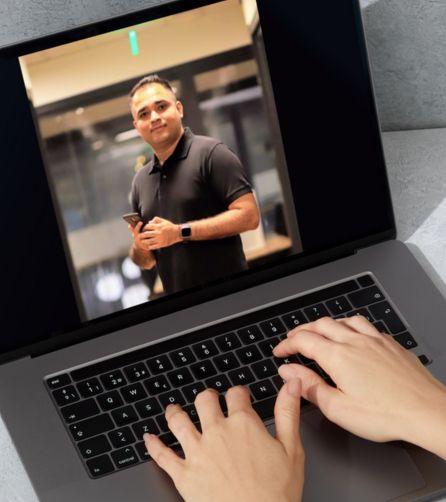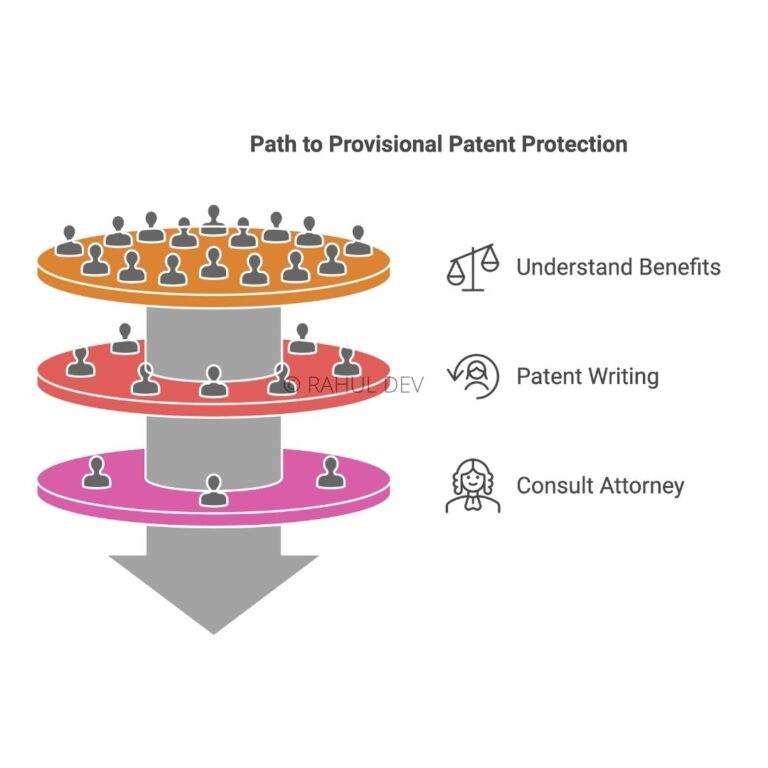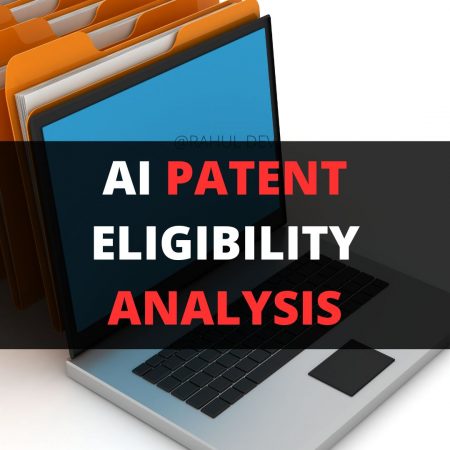AI Innovation Patent Eligibility
Insights by Dr. Rahul Dev

Understand Practical Aspects
Understand the process of determining patent eligibility AI inventions

Insights by Dr. Rahul Dev

Understand the process of determining patent eligibility AI inventions

Protect your innovations across multiple countries and create strong patent portfolio to boost business valuation
Local and global brand protection through international trademark registrations
Extensive research and business writing for technical whitepapers and B2B content products
Here I discuss AI Interface Detection Inventions and how to perform patent eligibility analysis for digital AI innovations. Patent eligibility analysis for AI interface detection inventions requires systematic evaluation of both prior art landscapes and technical merit criteria. The surge in AI patent applications, with 8,609 AI-related patents issued by the USPTO in 2024 alone, demands rigorous analysis to distinguish truly novel innovations from obvious combinations of existing technologies. This comprehensive approach ensures inventors invest resources wisely while patent attorneys build stronger applications that withstand examination scrutiny.
Specifically, the AI interface detection patents face unique challenges under Section 101 eligibility requirements. The 79% allowance rate in USPTO Tech Center 2100 contrasts sharply with business method rejections, highlighting the critical importance of framing inventions as technical solutions rather than abstract ideas. Recent cases like IBM v. Zillow (2024) demonstrate how inadequate prior art analysis can lead to patent invalidation even after grant.
This article covers following topics:
Prior Art Search for AI Interface Detection Inventions
Reviewing Invention Disclosure Documents of AI Interface Detection Inventions
Preparing Keyword Search Strings for AI Interface Detection Inventions
Patent Search Process for AI Interface Detection Inventions
Patent Eligibility Analysis Process for AI Interface Detection Inventions
Preparing Prior Art Search Report for AI Interface Detection Inventions


The prior art search for AI interface detection inventions begins with understanding the technology landscape’s complexity and competitive dynamics. The global patent search database contains 190,000 AI-related patents granted between 2000-2022, with major players like IBM holding 1,211 U.S. AI patents as of 2023. This concentration requires strategic search approaches that capture both foundational technologies and recent innovations.
While conducting a thorough patent search, the comprehensive database coverage forms the cornerstone of effective prior art searches. The USPTO’s Artificial Intelligence Patent Dataset (AIPD) provides structured access to U.S. AI patents from 1976-2023, enabling targeted filtering for interface-related technologies. EPO’s Espacenet offers global patent coverage with advanced Cooperative Patent Classification (CPC) search capabilities, while WIPO’s Patentscope captures Patent Cooperation Treaty applications that often represent early international filings for AI innovations.
The geographic patent search strategies must account for regional patent filing patterns. China leads globally with 38,210 generative AI patent filings from 2014-2023, yet only 7% of Chinese AI patents have been filed internationally. This gap creates potential blind spots in Western-focused searches that could miss relevant Chinese innovations. Japan’s 26,400 AI patent applications in 2024 similarly require dedicated attention through JPO databases and Japanese-language search capabilities.
The invention disclosure review establishes the technical foundation for comprehensive prior art analysis. AI interface detection inventions typically encompass computer vision algorithms for UI element recognition, machine learning models for interface behavior prediction, and automated systems for UI interaction control. Each component requires separate evaluation against existing patent literature. A technical specification analysis identifies core inventive concepts requiring prior art investigation. Neural network architectures and machine learning innovations designed specifically for graphical user interface analysis represent one category, including convolutional neural networks that identify buttons, menus, and text fields from screenshots. Training methodologies constitute another area, covering synthetic data generation, transfer learning techniques, and reinforcement learning frameworks for UI interaction improvement.
The system integration aspects often provide the strongest patent differentiation opportunities. Real-time processing pipelines, multi-modal input fusion, and feedback loops for continuous model improvement frequently represent novel combinations even when individual components exist in prior art. A claim scope assessment guides search strategy development by identifying broad versus narrow protection opportunities. Innovation boundaries must be clearly defined before conducting searches. The 25-38% decline in global AI patent filings reflects industry shift toward quality applications with substantial technical merit. Inventors should focus on genuine technical improvements rather than obvious combinations of known elements.
Keyword development strategies require balancing broad coverage with precision targeting. Core terminology mapping begins with primary invention concepts: “UI element detection,” “GUI automation,” “interface recognition,” and “screen analysis.” Each term generates synonym clusters that capture different patent drafting approaches used by various inventors and companies. Artificial intelligence terminology demands comprehensive coverage due to evolving language conventions. Search strings should include “machine learning,” “neural network,” “deep learning,” “computer vision,” and “artificial intelligence.” Technical specification keywords add precision: “CNN,” “convolutional neural network,” “object detection,” “image analysis,” and “pattern recognition.”
Application-specific terminology captures domain-focused patents that might use different language conventions. Robotic Process Automation (RPA) patents often use terms like “bot,” “automation,” “workflow,” and “task execution.” GUI testing patents employ “test automation,” “regression testing,” “UI validation,” and “interface verification.” Accessibility patents reference “assistive technology,” “screen reader,” and “adaptive interface.” The boolean search construction requires careful attention to operator precedence and database-specific syntax. USPTO searches benefit from proximity operators and classification code integration: ((“machine learning” OR “neural network”) AND (“user interface” OR “GUI”) AND (“detection” OR “recognition”)). Espacenet searches leverage CPC classification filtering combined with keyword queries for optimal precision. An iterative refinement processes improve search effectiveness through results analysis. Initial broad searches identify relevant classification codes and terminology patterns used in granted patents. Subsequent focused searches use refined keywords and classifications to achieve comprehensive coverage without excessive noise.
A systematic search methodology ensures comprehensive prior art coverage while maintaining efficiency. Phase 1 broad landscape mapping consumes approximately 30 minutes and establishes overall technology context. Google Patents provides quick access to global patent literature with automatic classification suggestions and full-text searching capabilities. Initial keyword searches across multiple databases identify key players and technology trends. IBM, Microsoft, Google, Amazon, Apple, and specialized RPA companies like UiPath and Automation Anywhere represent primary sources for relevant prior art. Timeline analysis reveals technology evolution patterns that guide deeper investigation priorities.
Phase 2 technical deep-dive requires 60-90 minutes for thorough analysis of identified patent families. USPTO AIPD filtering enables targeted examination of AI-specific patents with interface-related functionality. Classification code searches using G06F3/048 (graphical user interface techniques), G06N20/00 (machine learning), and G06T7/90 (image analysis) provide systematic coverage of relevant technical areas. Patent family analysis tracks international filing patterns and reveals strategic priorities of major patent holders. PCT applications often represent early international filings that indicate commercial importance and competitive threats. Continuation and divisional applications show ongoing development in specific technical areas.
Phase 3 competitive intelligence consumes 45 minutes and focuses on recent developments and emerging trends. 2022-2024 filing analysis captures current innovation directions that might impact patentability assessments. White space identification using commercial analytics tools reveals technical areas with limited patent coverage. Documentation standards ensure search reproducibility and support patent attorney collaboration. Search logs record databases consulted, search strings used, and results obtained. Reference classification organizes prior art by relevance and technical similarity to the invention under analysis.
Section 101 eligibility assessment applies the Alice/Mayo framework to determine patent subject matter eligibility. Step 1 analysis evaluates whether claims are directed to judicial exceptions including abstract ideas, natural phenomena, or laws of nature. AI interface detection inventions often trigger abstract idea analysis due to their algorithmic components and data processing elements. Technical improvement identification provides the primary path to eligibility under Step 2 analysis. USPTO’s July 2024 AI Guidance emphasizes that claims must describe “technical solutions to technical problems” rather than abstract algorithmic concepts. Successful examples like Amazon’s US11,221,833 demonstrate concrete technical improvements through specific system implementations.
Abstract idea avoidance strategies focus on claim language emphasizing technical implementation rather than algorithmic concepts. Generic computer implementation insufficient for eligibility requires specific hardware integration, technical process improvement, or measurable performance enhancement. Automation Anywhere’s pixel-vicinity filtering technique exemplifies this approach through specific technical limitations. Claim analysis frameworks evaluate independent and dependent claims separately. Independent claims must establish basic eligibility through technical improvement demonstration. Dependent claims add specific limitations that enhance technical character and provide fallback positions if broader claims face rejection.
Obviousness assessment under 35 USC §103 requires systematic comparison against prior art combinations. KSR v. Teleflex framework evaluates whether person of ordinary skill would be motivated to combine references with reasonable expectation of success. AI interface detection patents frequently face obviousness challenges combining known computer vision techniques with established UI automation methods.
An executive summary preparation provides concise overview of patentability assessment for patent attorney review. Key findings include most relevant prior art references, technical differentiation opportunities, and recommended claim strategies. Patentability likelihood assessment guides filing decisions and resource allocation priorities. The prior art reference organization groups patents by technical similarity and legal relevance. Primary references directly address similar technical problems with comparable solutions. Secondary references provide context for obviousness analysis or demonstrate alternative technical approaches. Background references establish general knowledge level in the relevant technical field.
Technical gap analysis identifies specific aspects of the invention that remain unaddressed in prior art. Novel combinations of known elements may achieve patentability through unexpected results or technical synergies. Implementation-specific improvements often provide strongest differentiation opportunities even in crowded technical fields. Search methodology documentation enables reproducibility and supports prosecution strategy development. Database coverage lists all resources consulted with date ranges and search strategies employed. Classification code analysis documents CPC and IPC codes relevant to the invention and their coverage in the search process.
A recommendation framework guides next steps based on search results. Green light scenarios indicate clear technical differentiation supporting broad claim strategies. Yellow flag situations suggest patentability with narrow claims focusing on specific technical improvements. Red flag outcomes recommend invention modification or alternative technical approaches before patent filing. The competitive intelligence integration provides strategic context beyond basic patentability assessment. Major patent holders in the AI interface detection space include IBM (1,211 AI patents), Google, Microsoft, Amazon, and specialized companies like UiPath and Automation Anywhere. Recent filing trends show the 25-38% decline reflecting quality-focused strategies that inventors should consider.
Therefore, the comprehensive patent eligibility analysis process ensures inventors make informed decisions about patent protection strategies. Technical differentiation remains possible even in crowded AI fields through specific implementations and novel problem-solution approaches. Strategic patent prosecution combined with thorough prior art analysis maximizes success probability while minimizing prosecution costs and delays.

As a business coach and thought leader, I cannot emphasize enough the importance of innovation, new software patents, mobile apps, and patents for tech companies, startups, and entrepreneurs. The world is rapidly evolving, and staying ahead of the curve is vital for success. Embracing technological advancements such as blockchain and AI can unlock unprecedented opportunities, streamline operations, and propel businesses into the future with competitive valuation via intangible assets.
Click Here for AI Startup Valuation Guide.
For instance, blockchain technology can revolutionize supply chain management and secure data sharing wherein innovative business models are explained to the audience via technical whitepapers, while AI can automate and optimize decision-making processes. Mobile apps are no longer just a luxury; they have become essential tools for engaging customers and offering personalized experiences. Furthermore, securing digital innovation patents is crucial for protecting intellectual property, fostering innovation, and maintaining a competitive edge. By investing in these areas, businesses can position themselves as industry pioneers and pave the way for a prosperous future after thoroughly conducting the due diligence and reviewing the legal opinion letters, which in case of digital assets can assist in determining the tokens as utility assets or coins as utility tokens before listing the assets at an exchange.
Our team of advanced patent attorneys assists clients with patent searches, drafting patent applications, and patent (intellectual property) agreements, including licensing and non-disclosure agreements. Advocate Rahul Dev is a Patent Attorney & International Business Lawyer practicing Technology, Intellectual Property & Corporate Laws. He is reachable at rd (at) patentbusinesslawyer (dot) com & @rdpatentlawyer on Twitter.
Quoted in and contributed to 50+ national & international publications (Bloomberg, FirstPost, SwissInfo, Outlook Money, Yahoo News, Times of India, Economic Times, Business Standard, Quartz, Global Legal Post, International Bar Association, LawAsia, BioSpectrum Asia, Digital News Asia, e27, Leaders Speak, Entrepreneur India, VCCircle, AutoTech).
Regularly invited to speak at international & national platforms (conferences, TV channels, seminars, corporate trainings, government workshops) on technology, patents, business strategy, legal developments, leadership & management.
Working closely with patent attorneys along with international law firms with significant experience with lawyers in Asia Pacific providing services to clients in US and Europe. Flagship services include international patent and trademark filings, patent services in India and global patent consulting services.
Global Blockchain Lawyers (www.GlobalBlockchainLawyers.com) is a digital platform to discuss legal issues, latest technology and legal developments, and applicable laws in the dynamic field of Digital Currency, Blockchain, Bitcoin, Cryptocurrency and raising capital through the sale of tokens or coins (ICO or Initial Coin Offerings).
Blockchain ecosystem in India is evolving at a rapid pace and a proactive legal approach is required by blockchain lawyers in India to understand the complex nature of applicable laws and regulations.